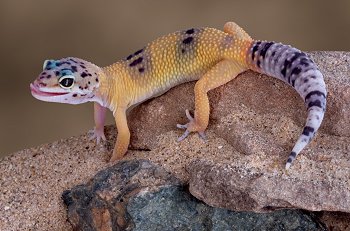Pet Health, Interesting Facts, and Trivia
Heat is a major factor in the health and well being of captive reptiles

Heat Sources and Daylight Cycles for Captive Reptiles: Different Spectrums for Different Purposes
Lighting is critical for captive reptiles. In nature, sunlight provides visible light, infra-red (heat) and ultraviolet (UV) radiation.
Reptiles are cold-blooded or ectotherms. They are dependent on their environment to regulate their core body temperature. The ambient (air) temperature of the enclosure is very important to regulate the body temperature and to prevent stress and disease.
Some activities such as digestion require higher spot temperatures. A raised heat source (such as a light or heat emitter) which shines onto a ground surface such as a rock will best simulate the basking areas of many tropical species. They need warm temperatures under the stomach for digestion. However, they often use sensitivity sensors on their back to decide when basking-time is over.
While the appropriate temperature for your reptile will depend on the species, captive reptiles can be provided with a zone of controlled temperatures using incandescent bulbs of varying wattage (and metal reflectors) depending on the size of the enclosure and the distance from the heat source to the animal.
Thermometers are Essential
Thermometers are essential to monitoring your reptile's habitat temperature, and one should be placed at each end of the enclosure to ensure that the temperature is appropriate throughout as well as appropriate for different purposes in different areas of the cage.
Day & Night Cycles are Important
Most captive reptiles are tropical or desert animals. Although the exact daylight/night cycle will vary from one species to another (depending on their native habitat), a 12-hour light/12-hour dark cycle is appropriate in most cases. Animals not provided an appropriate photo period are more likely to be stressed leading to suppression of the immune system and chronic infections.
Incandescent bulbs are NOT a sufficient source of UVB lighting used for Vitamin D3 production. However, they are a good source of UVA light spectrums which are important for stimulating your reptile's normal behaviors such as appetite and breeding.
Where heat without light is needed (during the night cycle), under tank heaters can keep the ambient temperature of the enclosure up.
Several types of "blue" lights also provide heat but are not disruptive to the night cycle of darkness needed for rest.
Fixtures Make Reptile Lighting and Heat Easy
There are many new hi-tech lighting fixtures which make light and heat a snap. Some hold daylight bulbs. Others hold daylight and night-light bulbs. Still others hold daylight, night-light and fluorescent bulbs in one unit -- with timers. See them in our reptile lighting pages.